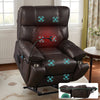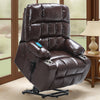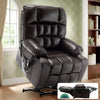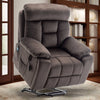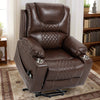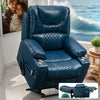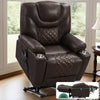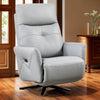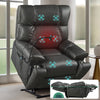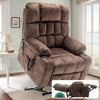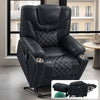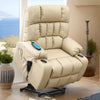Understanding Medicare Coverage
Eligibility Requirements for Durable Medical Equipment
Medicare provides coverage for various forms of durable medical equipment (DME), which can include lift chairs under certain conditions. To qualify, individuals must have a medical need for the equipment as prescribed by a doctor. Specifically for lift chairs, the qualifying condition typically involves a difficulty in standing up from a seated position due to certain medical issues like arthritis or other impairments. It's important for recipients to understand that Medicare will not cover the entire chair, but may cover the cost of the lifting mechanism if the chair is deemed medically necessary. Before purchasing a big and tall power recliner with the hope of reimbursement, patients should consult with their healthcare providers to determine eligibility and ensure documentation aligns with Medicare's requirements.

Distinction Between Medicare Part B and Part C
Medicare Part B and Medicare Part C differ in terms of the coverage they provide for medical equipment. Medicare Part B is considered the traditional Medical Insurance, and it primarily covers medically necessary services and supplies. If a doctor prescribes a lift chair as a necessary piece of durable medical equipment (DME), Medicare Part B may cover the lifting mechanism, but not the chair part itself.
On the other hand, Medicare Part C, also known as Medicare Advantage, is an alternative that allows beneficiaries to receive their Medicare benefits through private health insurance plans. These plans must cover everything that Original Medicare covers but can also offer additional benefits. Therefore, if you have a Medicare Advantage plan, it may cover additional costs associated with the lift chair that Part B does not cover. However, coverage can vary significantly from plan to plan, so it's crucial to check with your specific insurer.
The Seat-Lift Mechanism and Medicare
What Constitutes a Seat-Lift Mechanism
A seat-lift mechanism is a device designed to assist individuals when rising from a seated position. In the context of Medicare coverage, this mechanism qualifies as durable medical equipment (DME). It must include a motorized lift that operates smoothly and can be controlled by the user to rise to a standing position or lower to a seated position without other assistance. To be covered by Medicare, the seat-lift mechanism should not be part of a full recliner or couch, but instead, it is the lifting system that can be incorporated into a piece of furniture. Medicare will not cover the entire lift chair, but it may cover the cost of the seat-lift mechanism if it's proven to be medically necessary. Therefore, when seeking Medicare's help for a lift chair, the emphasis should be on the medical need for this specific feature.
How Medicare Coverage Applies to Lift Chairs
Medicare's coverage for lift chairs often falls under the durable medical equipment (DME) category, specifically within Medicare Part B. To qualify, the lift chair must include a seat-lift mechanism that's essential for treating your condition. It's crucial to note that Medicare won't cover the entire cost of the lift chair. Typically, it will only reimburse for the seat-lift mechanism part, and not the whole furniture component. This means if you choose a big and tall power recliner, Medicare may only pay for the mechanized lift part built into the recliner.
To have Medicare help cover the costs, you need to meet specific criteria. Your doctor must certify that you have a medical condition requiring a lift chair, that you're capable of operating the mechanism, and that this equipment can improve your condition or prevent it from worsening. Once these conditions are met, Medicare Part B typically covers 80% of the approved amount for the mechanism after you meet your deductible. You are responsible for the remaining 20%, as well as any additional costs for the unfunded parts of the chair.
Procedure to Obtain a Medicare-Covered Lift Chair
Documentation Needed from Doctors
To get a lift chair covered by Medicare, it's important to have the correct documentation from your doctor. This includes a prescription stating that the lift chair is medically necessary due to your condition. The prescription must specify that you have severe arthritis of the hip or knee or a severe neuromuscular disease. It should also attest that you're unable to stand up from a regular chair but can do so from a lift chair. Furthermore, the doctor should confirm you can operate the chair safely, and that the chair will improve, slow down, or stop the deterioration of your condition. Additionally, your doctor must be enrolled in Medicare and willing to provide the necessary medical records to support the claim.
Steps to Apply for Coverage
To apply for coverage for a big and tall power recliner lift chair under Medicare, there are specific steps you must follow:
- Consult with Your Doctor: Your first step is to schedule a consultation with your doctor. This is to ascertain that a lift chair is medically necessary for your condition.
- Obtain a Prescription: If your doctor deems a lift chair necessary, they will write a prescription which includes their diagnosis, treatment plan, and how the chair will help with your condition.
- Choose a Medicare-Approved Supplier: Only suppliers approved by Medicare can ensure coverage. Look for a supplier that offers Medicare-approved lift chairs.
- Submit Paperwork: Provide your prescription along with the Medicare forms and any additional required documentation to the supplier.
- Wait for Approval: After submitting your paperwork, there will be a waiting period for Medicare to review and approve the claim.
- Purchase and Get Reimbursed: Once approved, you can proceed to purchase your lift chair. Medicare will then reimburse you for the cost of the lift mechanism, not the entire chair.
Remember, timely submission of accurate paperwork will help streamline the process and increase the chances of getting your lift chair covered by Medicare.
Contributory Costs and Reimbursement
Understanding Co-Pays and Deductibles
When considering a big and tall power recliner with a lift feature, it's important to understand the costs not covered by Medicare. These out-of-pocket expenses are known as co-pays and deductibles. A co-pay is a fixed amount you pay for a covered health service, which you're responsible for after your deductible – the amount you spend before your Medicare plan starts to pay. For example, if a lift chair costs $1,000 and your co-pay is 20%, you would pay $200. The deductible is how much you must pay within a year before your plan begins to cover services. This amount varies depending on your plan and could change annually. It's crucial to consider these costs when budgeting for your lift chair purchase, as they will directly impact the final amount you'll be responsible for paying.
Process of Reimbursement for Lift Chairs
Navigating the process for reimbursement for a lift chair under Medicare can be broken down into a few key steps. Once the doctor has provided the necessary documentation confirming the medical need for a lift chair, and you have purchased your lift chair from a Medicare-approved supplier, you'll need to submit a claim for reimbursement. It's important to keep all receipts and paperwork from your purchase as they will need to be included in your claim.
Typically, you or your supplier will submit a claim to Medicare for the seat-lift mechanism. After Medicare receives the claim, they will review it and, if approved, they will reimburse you for the Medicare-approved amount. However, remember that the reimbursement will only cover the cost of the seat-lift mechanism portion of the lift chair, and not the full cost of the furniture. You are responsible for paying the deductible and co-insurance amounts as well as any remaining balance for the lift chair itself.
Alternative Financial Assistance for Lift Chairs
Medicaid and Other State-Run Programs
For individuals who require financial aid beyond what Medicare provides for a lift chair, Medicaid and state-run programs may offer additional assistance. Medicaid coverage varies by state but often includes the poor and disabled with a variety of benefits, potentially covering the full cost of a lift chair. Eligibility for Medicaid assistance depends on factors such as income and resources. Besides Medicaid, various states have specific programs designed to assist those in need of durable medical equipment like lift chairs. These programs may have different names and eligibility requirements, which can be checked with local social service offices. By exploring these options, qualifying individuals might secure the financial support necessary to obtain a necessary big and tall power recliner or other types of lift chairs.
Charities and Non-Profit Organizations
Beyond Medicare, there are other forms of financial assistance for those in need of a lift chair. Charities and non-profit organizations often provide aid to individuals with limited resources. For example, organizations dedicated to supporting the elderly or disabled may have programs or grants specifically designed to fund durable medical equipment like lift chairs. Non-profits may also offer rental programs or accept donations of gently used equipment, which can be a cost-effective alternative. To access these resources, individuals should reach out to local social services, healthcare providers, or look for national charities that offer aid to those with mobility issues.
Different Types of Lift Chairs
Features of a Big and Tall Power Recliner
Big and tall power recliners are designed to accommodate larger body sizes with features that provide extra comfort and support. These chairs typically have a stronger and reinforced construction, with thicker cushions, wider seats, and higher backs. They also usually include a heavy-duty lifting mechanism that can handle more weight than standard models. To enhance comfort, many come with additional padding, lumbar support, and adjustable positions. Some models might feature extra amenities like heating, massage functions, or convenient storage pockets. With their robust design, big and tall power recliners help ensure that individuals with larger frames can enjoy the benefits of a lift chair safely and comfortably.
Pros and Cons of Various Lift Chair Models
Lift chairs come in a variety of models, each with their own set of advantages and disadvantages. One primary benefit of a traditional lift chair is the assistance it provides users in standing up from a seated position, which can be particularly useful for individuals with limited mobility or strength. Standard models are typically more affordable and offer essential features such as basic recline functionality and a lifting mechanism.
However, there are drawbacks to consider as well. Some models may lack advanced features like heating or massage, which are available in higher-end chairs. They might also have a lower weight capacity and not be suited for big and tall individuals. While these chairs can offer significant convenience, the initial cost and potential lack of certain functions should be weighed when making a decision.
On the other hand, big and tall power recliners are designed to accommodate larger individuals, offering more space and robust support. These chairs often come with a higher weight capacity, stronger motors, and more spacious seating areas. They also tend to have longer durability due to their sturdy construction.
Despite these benefits, big and tall power recliners can be quite expensive, possibly making them less accessible to some individuals. They could also be bulkier and require more space in a room, which might not be suitable for smaller living areas. Additionally, because of their specific design, they may not fit well into every home aesthetic.
In conclusion, each lift chair model has its own set of pros and cons. When considering a purchase, it's important to take into account individual needs, space constraints, and budget to find the right balance between comfort, functionality, and cost.
Purchasing Tips for Medicare-Approved Lift Chairs
Identifying Medicare-Approved Suppliers
When looking for a lift chair, especially a big and tall power recliner, it is essential to purchase from a supplier recognized by Medicare to ensure coverage. Approved suppliers have been vetted by Medicare and comply with specific standards. To find such suppliers, beneficiaries can visit the official Medicare website or contact Medicare directly for a list of approved providers. Additionally, consulting with the issuing doctor or healthcare provider may offer recommendations for local, reliable suppliers that support Medicare billing. Always verify the supplier's Medicare approval status before making a purchase to avoid any issues with reimbursement.
Avoiding Common Pitfalls in Purchasing
When pursuing the purchase of a big and tall power recliner that's covered by Medicare, it's crucial to steer clear of certain pitfalls to ensure a smooth and cost-effective experience. Firstly, verify that the supplier is authorized by Medicare to avoid any coverage issues. Always ask for a detailed breakdown of costs upfront to prevent hidden fees. Don't overlook the importance of the seat-lift mechanism prescription from your doctor, as it is necessary for Medicare coverage. Additionally, be wary of high-pressure sales tactics that may lead you to buy additional features or warranties that are not covered by Medicare. Finally, take the time to read and understand the return policy. In case the chair doesn't meet expectations or needs, knowing the return process can save you from unnecessary expenses and hassle.
Maintenance and Warranty of Lift Chairs
Warranty Coverage for Lift Chairs
When considering a big and tall power recliner that qualifies as a lift chair, understanding the warranty is crucial for securing your investment. Lift chairs covered by Medicare come with a warranty which typically encompasses the lifting mechanism, electrical parts, and the frame of the chair. The duration of the warranty varies by manufacturer, but most offer a one-year warranty on parts and service. Some may extend coverage for specific components like the frame, which could have a warranty for several years. It's important to read the warranty details carefully to know what's included and for how long. Keep in mind that additional protection plans might be available for purchase, providing extended coverage beyond the standard warranty period. Always keep your warranty documentation safe in case you need to claim repairs or replacements.
Tips for Long-Term Maintenance
Caring for your big and tall power recliner is crucial to ensure its longevity and maintain its functionality. Here are some tips to help you maintain your lift chair over the long term:
- Regular Cleaning: Wipe down the upholstery with a suitable fabric cleaner to remove dirt and stains. For leather models, use a leather conditioner to prevent cracking.
- Inspect Mechanical Parts: Check the lift mechanism and power system regularly for any signs of wear and tear. If you spot any issues, contact the manufacturer for repairs.
- Avoid Excess Weight: Do not exceed the recommended weight capacity of the chair, as this can strain the motor and lift mechanism.
- Keep Liquids Away: Liquids can damage the electrical components of the chair. Avoid eating or drinking while seated in the recliner.
- Follow Manufacturer Instructions: Use the recliner as directed in the user manual. Misuse can lead to malfunctions and may void the warranty.
- Schedule Professional Servicing: Have a certified technician service the chair periodically to ensure all components are in good working order.
By following these maintenance tips, you can help ensure your lift chair remains a comfortable and reliable part of your home.








